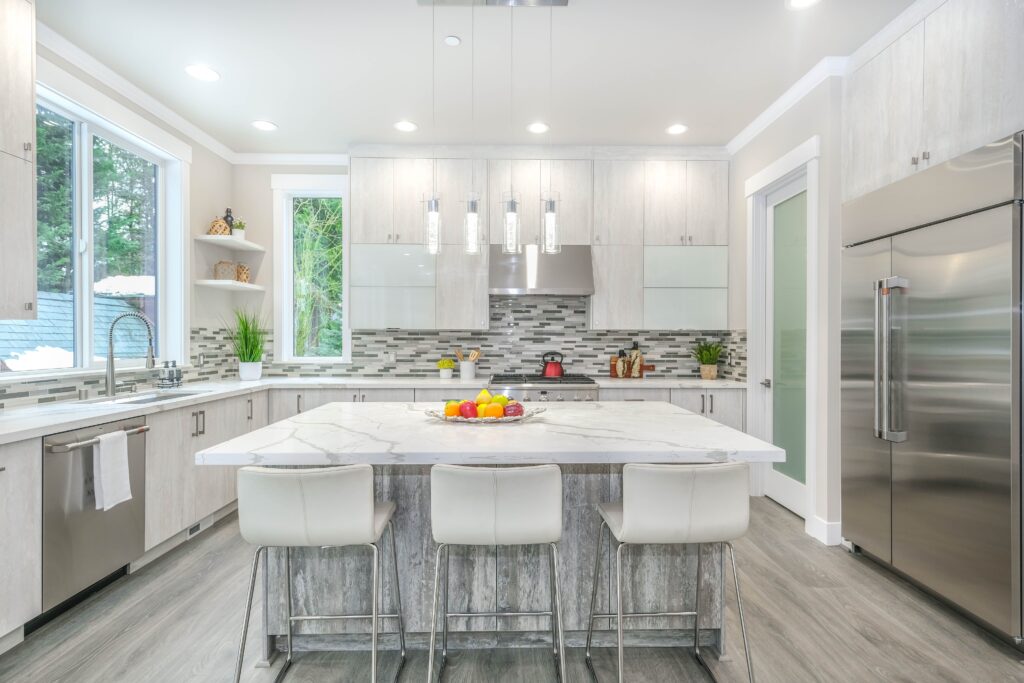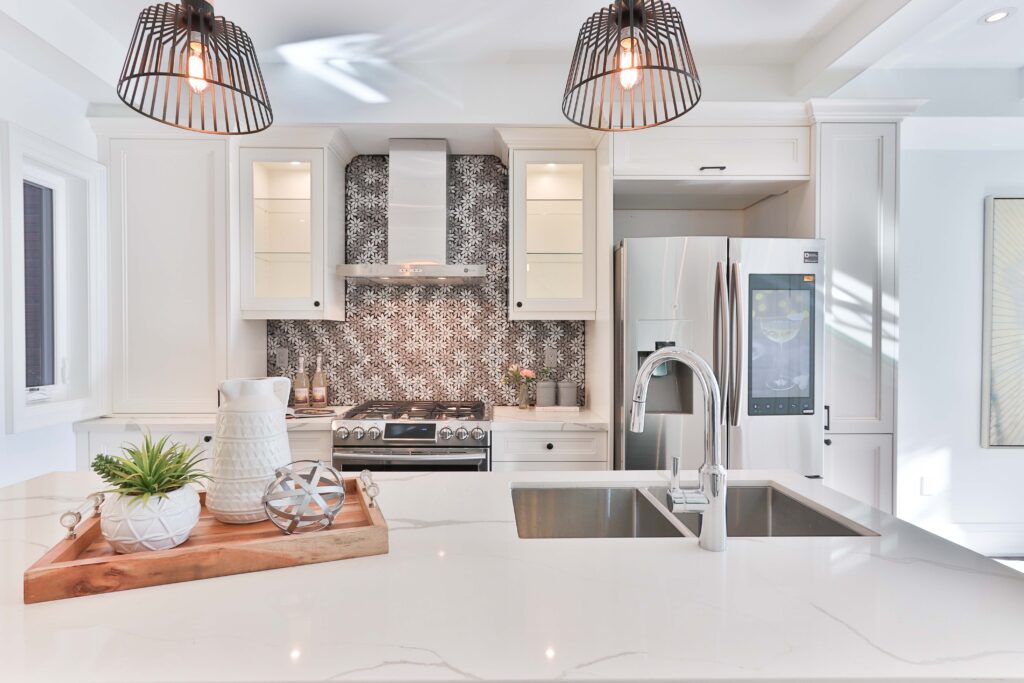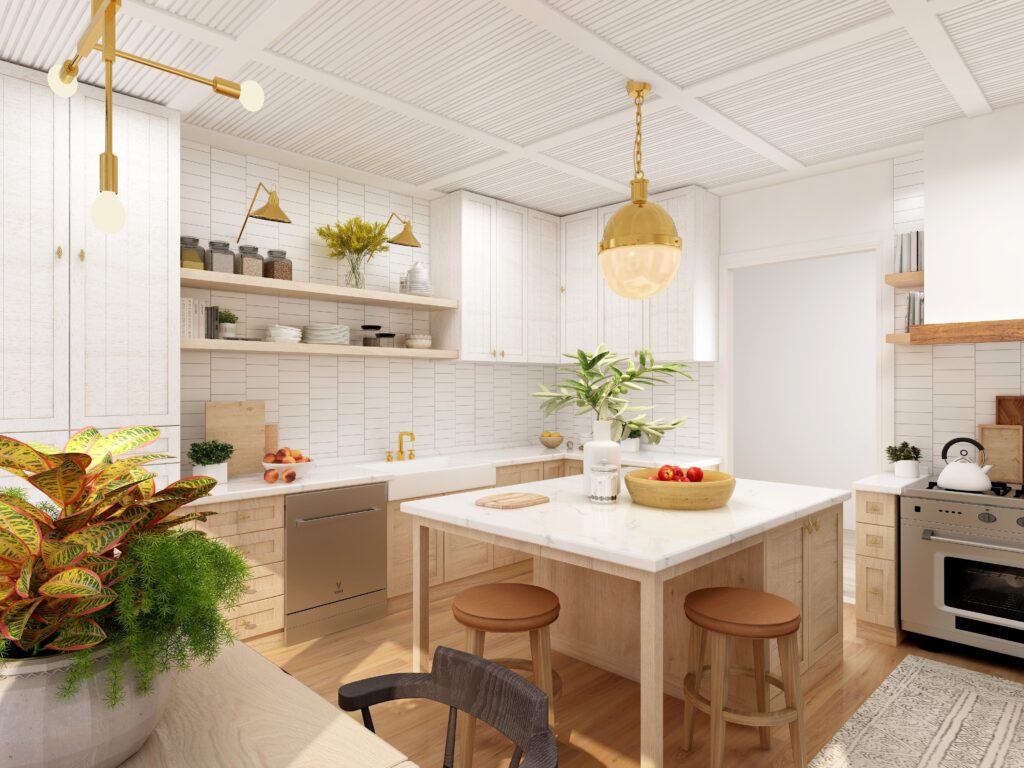In today’s fast-paced world, many individuals are embracing minimalism as a way to simplify their lives and create a sense of calm in their surroundings. One area where minimalist principles can be applied is in the kitchen. Minimalist kitchen decor focuses on creating a clean, uncluttered space that promotes efficiency and a sense of tranquility.
In this article, we will explore the key principles of minimalist kitchen decor, provide design ideas, and offer tips on maintaining a minimalist kitchen.
Definition of minimalist kitchen decor
Minimalist kitchen decor is characterized by its simplicity, functionality, and lack of clutter. It involves streamlining the kitchen space to include only essential items, creating a clean and organized environment.

Benefits of minimalist kitchen decor
A minimalist kitchen offers numerous benefits. It reduces visual distractions, making it easier to focus on cooking and meal preparation. It also promotes efficient workflow and reduces the time spent searching for items. Additionally, a minimalist kitchen is visually appealing and can increase the overall value of your home.
Importance of decluttering
Decluttering is a crucial aspect of minimalist kitchen decor. It involves removing unnecessary items from your kitchen and organizing the remaining essentials in an efficient manner. Decluttering not only creates a sense of calm but also makes it easier to maintain a clean and tidy kitchen.
Key Principles of Minimalist Kitchen Decor
To achieve a minimalist kitchen, there are several key principles to follow.
Simplify the color palette
Start by simplifying the color palette in your kitchen. Opt for neutral colors such as white, beige, or gray, as they create a clean and timeless look. These colors also provide a sense of openness and make the space appear larger.
Declutter and organize
Clear your kitchen of any unnecessary items that do not serve a practical purpose. Donate or discard items that are rarely used or no longer needed. Organize your remaining kitchen essentials in a logical and efficient manner. Use drawer dividers, storage containers, and labels to maintain order.

Optimize storage solutions
Invest in storage solutions that maximize space utilization. Install deep drawers, pull-out shelves, and vertical storage racks. Utilize the inside of cabinet doors for additional storage by adding hooks or racks. By optimizing storage, you can keep countertops free from clutter.
Embrace clean lines and simple designs
Choose furniture and appliances with clean lines and simple designs. Minimalist kitchen decor often features sleek and unadorned cabinets, countertops, and hardware. This helps create a visually pleasing and harmonious space.
Choosing Minimalist Kitchen Furniture and Appliances
When selecting furniture and appliances for your minimalist kitchen, consider functionality and simplicity.
Selecting functional and versatile furniture
Choose furniture that serves a practical purpose and offers versatility. Opt for multifunctional pieces, such as kitchen islands with built-in storage or dining tables that can double as workspaces. Avoid bulky or ornate furniture that adds unnecessary visual weight to the space.
Opting for sleek and minimalist kitchen appliances
Invest in kitchen appliances with a minimalist design. Look for sleek, stainless steel appliances with clean lines. Consider built-in or integrated appliances to maintain a seamless and uncluttered appearance. Keep only essential appliances on your countertops to maximize workspace.
Maximizing countertop space
Minimize the number of items on your countertops to create a sense of openness. Store small appliances, utensils, and other items in cabinets or drawers. Utilize wall-mounted racks or magnetic strips to keep frequently used items easily accessible while saving valuable countertop space.

Minimalist Kitchen Design Ideas
To inspire your minimalist kitchen decor, here are some design ideas:
Utilizing open shelving
Open shelving is a popular choice for minimalist kitchens. It provides a sleek and airy look while displaying your kitchen essentials. Keep the shelves organized and visually appealing by arranging items in a neat and intentional manner.
Incorporating natural materials
Introduce natural materials into your kitchen design to add warmth and texture. Use wooden cutting boards, bamboo utensils, or stone countertops. These materials not only enhance the aesthetic appeal but also promote sustainability and a connection to nature.
Integrating hidden storage solutions
Conceal clutter and maintain a clean look by incorporating hidden storage solutions. Consider installing a pantry with sliding doors or pull-out shelves. Opt for cabinets with touch-to-open mechanisms or recessed handles for a seamless appearance.
Emphasizing minimalistic lighting fixtures
Choose lighting fixtures that complement the minimalist style. Opt for recessed or track lighting to provide ample illumination without cluttering the visual space. Consider pendant lights with clean lines and simple designs as focal points.
Creating a Minimalist Kitchen Workflow
In addition to the design elements, it’s essential to establish an efficient workflow in your minimalist kitchen.
Designing an efficient layout
Arrange your kitchen in a way that facilitates a smooth workflow. Place frequently used items within easy reach, such as utensils near the stove and cutting boards near the food preparation area. Minimize the distance between the sink, stove, and refrigerator to optimize efficiency.
Minimizing kitchen utensils and gadgets
Simplify your kitchen utensils and gadgets by keeping only the essentials. Assess which items you use regularly and eliminate duplicates or items that serve a single-purpose. This reduces clutter and makes it easier to find what you need when you need it.
Establishing zones for specific tasks
Create designated zones in your kitchen for specific tasks. For example, designate an area for food preparation, cooking, and cleanup. This helps maintain order and streamlines the cooking process.

Maintenance and Upkeep of a Minimalist Kitchen
To keep your minimalist kitchen looking its best, follow these maintenance tips:
Regular cleaning and decluttering routines
Set aside time regularly to clean and declutter your kitchen. Wipe down countertops, clean appliances, and organize storage spaces. Incorporate decluttering habits into your routine to prevent the accumulation of unnecessary items.
Mindful grocery shopping and meal planning
Practice mindful grocery shopping by buying only what you need and will use. Avoid excessive stockpiling of ingredients or kitchen gadgets. Plan your meals to minimize food waste and ensure ingredients are used efficiently.
Avoiding unnecessary kitchen accessories
Resist the temptation to add unnecessary accessories to your kitchen. Avoid decorative items that do not serve a practical purpose. Keep countertops clear of excessive decor, allowing the minimalist aesthetic to shine through.
Conclusion
Minimalist kitchen decor offers a refreshing and organized approach to kitchen design. By simplifying the color palette, decluttering and organizing, optimizing storage solutions, and embracing clean lines, you can create a functional and visually pleasing space. Remember to design an efficient workflow, maintain regular cleaning and decluttering routines, and avoid unnecessary accessories. Embrace the simplicity and tranquility that minimalist kitchen decor brings to your home.
FAQs
1. How do I start decluttering my kitchen?
To start decluttering your kitchen, begin by removing items that you rarely use or no longer need. Sort through your pantry, cabinets, and drawers and donate or discard items that are taking up unnecessary space. Organize your remaining essentials in a logical and efficient manner.
2. What color palette works best for a minimalist kitchen?
A neutral color palette works best for a minimalist kitchen. Opt for shades of white, beige, or gray to create a clean and timeless look. These colors provide a sense of openness and make the space appear larger.
3. Can I still have decorative elements in a minimalist kitchen?
While minimalist kitchens typically focus on simplicity and functionality, you can still incorporate decorative elements. However, choose items that serve a practical purpose and enhance the overall aesthetic without overwhelming the space.
4. What are some space-saving storage solutions for a small kitchen?
For a small kitchen, consider utilizing vertical space by installing shelves or hanging racks. Maximize cabinet and drawer space by using organizers, dividers, and pull-out shelves. Utilize the inside of cabinet doors for additional storage with hooks or racks.
5. How can I incorporate sustainability into my minimalist kitchen?
Incorporate sustainability into your minimalist kitchen by choosing eco-friendly materials, such as bamboo or reclaimed wood. Opt for energy-efficient appliances and reduce waste by practicing mindful grocery shopping and meal planning. Additionally, consider composting and recycling options to minimize your environmental impact.
